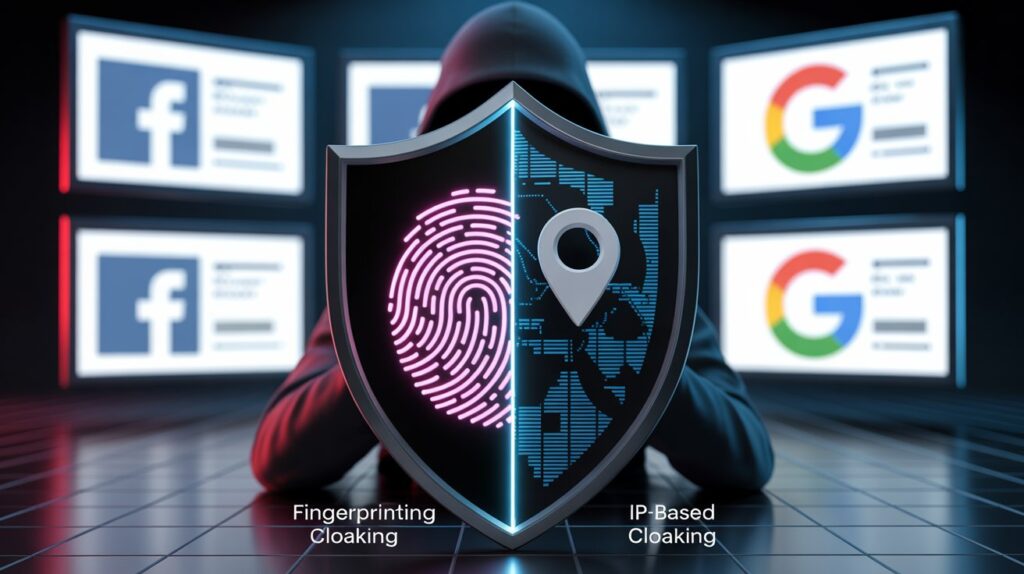Stay Live. Stay Profitable. Choose the Best Cloaker.

Running Facebook or Google Ads in 2025? You already know how ruthless ad platforms have become. One wrong move, one aggressive lander, and you’re banned before you can blink. That’s why cloaking is more than a trick now—it’s a lifeline. And if you’re hunting for the best cloaker, chances are you’re comparing IP-based and fingerprinting methods. One’s old-school, the other’s next-gen. But which one actually keeps your campaigns live?
Let’s cut through the noise and get into it.
What Is Cloaking, Really?
Cloaking is how marketers serve one version of a landing page to bots or moderators, and a completely different one to real users.
So if a Facebook rep clicks your ad, they see a boring, compliant page. But if it’s a real user? They’re taken straight to your money-maker—nutra, dating, sweepstakes, crypto, whatever you’re running.
Done right, cloaking keeps your accounts safe, your offers converting, and your spy-tool-snooping competitors in the dark.
The Basics: How IP Cloaking Works
This is the OG method. Your cloaker checks a visitor’s IP address and filters them based on known blacklists—think Amazon Web Services, Google data centers, known reviewer IPs, and VPNs.
When It Works:
- Blocks basic bots
- Flags common spy tool IPs
- Filters traffic with minimal setup
The Problem?
Ad reviewers are smarter now. They rotate IPs. They use residential proxies. Some even spoof clean user behavior. IP-only filtering can’t keep up anymore.
If you’re still using IP-based cloaking as your main defense in 2025, you’re basically locking the front door and leaving the back wide open.
Enter Fingerprinting Cloaking
Now we’re talking serious defense. Fingerprinting collects tiny pieces of data from each visitor to figure out who they really are.
We’re talking:
- Browser version
- Screen resolution
- Fonts and plugins
- Timezone
- Canvas fingerprint
- Device memory
- Mouse behavior
It’s like digital forensics—if something doesn’t feel right, fingerprinting cloaking flags it. No matter what IP they’re using.
Why It Works:
- Catches stealth bots and disguised reviewers
- Blocks residential proxies
- Detects abnormal user behavior (like no mouse movement or fast click-throughs)
Small Trade-Off:
- Needs a bit more setup
- Can slightly impact page load time if poorly optimized (but any good cloaker has this sorted)
Side-by-Side: Which Is More Effective?
| Feature | IP-Based Cloaking | Fingerprinting Cloaking |
|---|---|---|
| Blocks basic bots | Yes | Yes |
| Detects stealth traffic | No | Yes |
| Ad reviewer defense | No | Yes |
| Setup simplicity | Easy | Moderate |
| Long-term reliability | Low | High |
So, which wins?
Fingerprinting cloaking isn’t just the better option—it’s the only option if you’re serious about staying live in 2025.
That said, the best cloaker uses both methods. Layered defense. Double the protection.
What to Look for in the Best Cloaker
Not all cloakers are created equal. Some promise the world but fold the moment Facebook sneezes.
Here’s what a real, reliable cloaker should offer:
- IP + fingerprinting detection
- Bot filtering and spoof protection
- Geo/device/language targeting
- Custom rule creation (by referrer, OS, time, etc.)
- Integration with FB, Google, TikTok, native, etc.
- Real-time reporting
- Fast redirects (under 100ms)
- Ongoing updates and support
Looking for one that does it all? TrafficShield is a good place to start. It’s built by media buyers, for media buyers.
Real-World Example: Cloaking That Actually Works
A mid-sized media buyer was burning through Facebook accounts—getting banned every few days. They were using a basic IP-based cloaker.
Once they switched to Trafficshield, here’s what changed:
- Bot hits dropped by 65%
- Reviewer traffic got blocked 98% of the time
- Campaigns stayed live for 3–4x longer
- They doubled their ROI in 6 weeks
You don’t need more ad copy tweaks. You need better filtering.
Read this: How Trafficshield Cloaker Helped an Affiliate Marketer 3X Their Campaign Scale
Where Cloaking Is Most Useful
Still wondering if you even need a cloaker?
Here’s when it becomes non-negotiable:
- Running aggressive offers (nutra, casino, lead gen, adult)
- Launching campaigns on FB, Google, TikTok
- Protecting funnels from spy tools
- Filtering bad clicks or click-farm traffic
- Staying safe during review cycles or manual checks
- Scaling fast without getting flagged
Cloaking doesn’t just “help” in these cases—it’s what makes the whole thing possible.
Final Word: Stop Flying Blind
Here’s the deal: ad networks won’t slow down. Their AI, reviewers, and traffic scans get smarter every year.
If you want to keep scaling, protect your spend, and stay invisible, you need the best cloaker. Not the cheapest. Not the flashiest. The one that actually works.
Fingerprinting cloaking is your shield. IP cloaking is your first filter. Together? You’re bulletproof.
Want that kind of protection?
Try TrafficShield — built for performance marketers who are done losing accounts and burning budgets.
FAQ: Cloaking in 2025
1. What’s the best cloaker for Facebook ads?
You need a cloaker that uses both IP filtering and fingerprinting. TrafficShield is one option that checks both boxes.
2. Is cloaking illegal?
Nope. But it does break ad platform policies. Use it at your own risk. Many top affiliates still use it successfully.
3. Does fingerprinting beat AI reviewers?
It’s the best line of defense right now. Fingerprinting can detect patterns AI reviewers use, including device quirks and behavior.
4. Can I just use IP cloaking?
You can. But don’t expect it to hold up against advanced bots or reviewers using residential proxies.
5. Will cloaking affect my page speed?
Only if the cloaker is poorly built. Any good cloaker should deliver fast redirects without delays.




